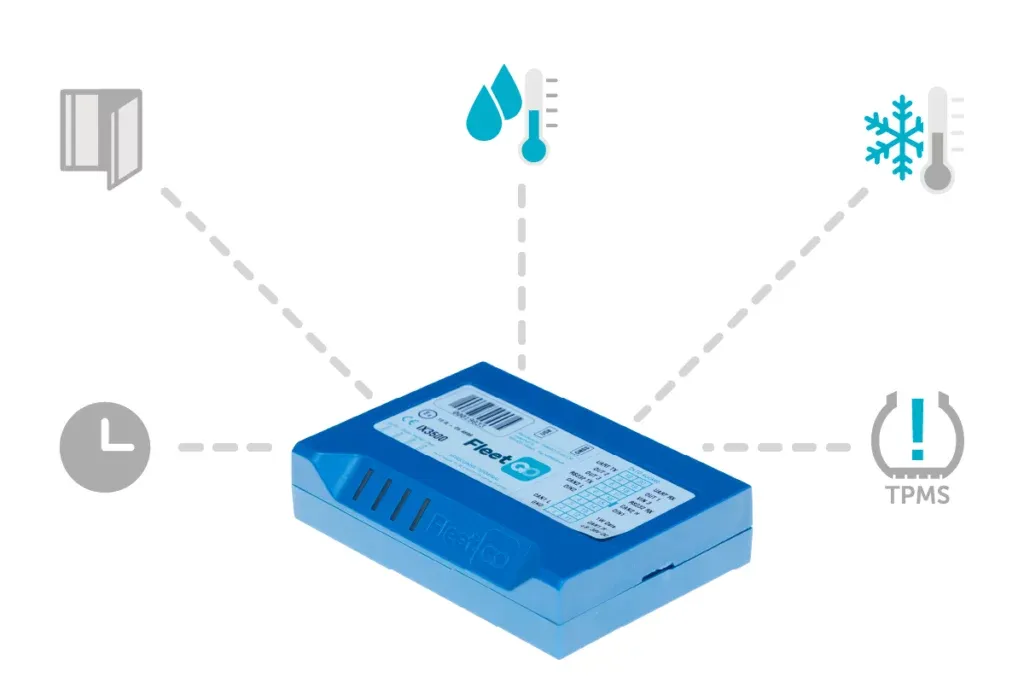Trucking companies have recently embraced telematics technology to improve fleet management and productivity. Part of the evolution is using telematics devices in fleets to collect real-time data and transmit it to fleet management software for analysis. For fleet companies to gather business intelligence for decision-making, they rely on telematics devices installed in vehicles. Some devices can be plug-and-play, while others require installation and extra wiring to collect critical data, such as location and speed. Discover the various types of telematics devices and their uses.

What is a Telematics Device?
A telematics device is an instrument installed in a vehicle to collect telemetry data. The device usually has a GPS receiver that collects information on the location and performance of the vehicle. The collected information is transmitted through a wireless network to other systems or devices. Fleet managers can access information from the GPS receiver through fleet management software. Telematics technology combines hardware and software components for GPS tracking and cloud services to analyse data. A telematics device is usually a black box device connected to an interface inside the vehicle, which collects data.
Various types of telematics devices are available on the market, including the following:
- OBDII telematics devices: They are the most common telematics devices usually plugged into the vehicle’s onboard diagnostic port. They have a well-established workaround and allow routine data transfer through mobile networks.
- Bluetooth-powered telematics systems: Some telematics devices allow data transmission through Bluetooth. The device is usually attached to the vehicle’s centre console and records driver behaviour data.
- Smartphone-based telematics devices: It is a smartphone-based driver assistance tool that doesn’t require any set-up. It relays data from the black box, making data and fleet tracking easier.
- Black box telematics system: Usage-based insurance (UBI) initiatives in the UK rely on black box innovation to capture vehicle data. The information is relayed through cell phone connectivity to a data centre.
- 12v plug-in self-installation telematics devices: The device connects to the vehicle’s 12v socket and collects driver behaviour information. Some versions have USB plugs to reduce the risk of the devices being knocked around.
What Does a Telematics Device Do?
Telematics devices comprise a GPS tracking unit and other onboard sensors working together to monitor the status and activities of a vehicle. The functions of a telematics device include:
Data collection
A telematics device has tools for collecting data from a vehicle, such as:
- Sensors: Vehicle sensors collect data on driver behaviour. For instance, they record aggressive driving, risky manoeuvres, fast acceleration or harsh braking. Sensors in telematics devices also track a vehicle’s overall health and the driver’s actions. They can record door opening and temperature inside the cab.
- GPS: The device gathers data on the vehicle’s location and transmits the information in real time. Fleet managers can also use GPS technology to track speed and movements like idle time and stops.
- Engine diagnostics: The engine data records pulse inputs to monitor the vehicle’s fuel flow and maintenance state. The information is transmitted in real-time for better fleet maintenance and operations solutions.
Data storage
A telematics device doesn’t just gather information. When information from the sensors and GPS tracking devices is collected in the telematics device, the data is stored in the receiver. Information shared in real-time from the telematics devices is also available from the vehicle for download.
Data transmission
A telematics device has wireless or Bluetooth data transmission capabilities to allow sharing of data to secure servers. Telematics devices rely on satellite communication, GPRS or cellular networks to relay information in real-time or share data periodically. The receiving server decodes the data and processes it for further use. The information is usually accessible from fleet management software or a mobile phone application.
How to Install Telematics Devices
Modern vehicles and trucks come equipped with a telematics device. If the vehicle doesn’t have a telematics device, it is easy to install. The telematics box installation is a simple process, especially for vehicles made after the mid-1990s since they have a port compatible with the device under the dashboard. The steps for installing a telematics device include:
- Find the onboard diagnostics port (OBDII): The first step is to find the OBDII port of the vehicle. It is usually near the steering column underneath the dashboard. Removing the dash panels makes it easier to find the port.
- Clear the OBDII port: The ignition should be off when installing the telematics device. Testing the voltage before removing the bolts that hold the OBDII port in place is also important. When the port is clear, place the mounting bracket over the port and push it in place.
- Plug in the bypass connector and connect the PNP device: With the bypass connector plugged in, the port is tightened using a screw, and the bypass cable is pulled through the dashboard. The PNP device and bypass connector are also secured with zip ties.
- Activate the telematics device: Complete the registration process and activation instructions for the device to collect data before reassembling the dashboard panel.
In some vehicles, the installation process is simpler if it doesn’t require a bypass connector. When the connector is unnecessary, the telematics device is plugged into the OBDII port and activated. Manufacturers usually provide information for installing the devices in various vehicles or equipment.
Why Install Telematics Devices?
Telematics devices are crucial technologies for fleet management. Here are reasons for installing telematics devices:
- Safety and security: Fleet owners install telematics devices to monitor the safety of the vehicles. With driver behaviour reporting and incident notification, fleet managers can improve the safety of drivers by providing training based on driving habits. Telematics devices have GPS trackers for tracking stolen vehicles. Hence, fleet managers always know where their vehicles are and can track missing trucks or containers.
- Improved customer service: With real-time GPS tracking, route optimisation tools and trip reporting, fleets can provide better customer service. For instance, fleet managers can provide accurate delivery times and optimise routes to speed up delivery times. Providing accurate information to customers builds trust and improves revenue.
- Reduced fuel costs: Telematics devices provide real-time data on fuel consumption, and fleet managers can identify causes of unusual fuel wastage. Fleet companies can also optimise routes to reduce the distance covered and fuel consumption.
Telematics Devices Cost
When determining the cost of a telematics device, it is important to consider the entire system. Fleet managers looking for a telematics device must pay for the gadget, installation and subscription fee for the fleet management software. The cost variables depend on the device you choose. For instance, a real-time device that can transmit data has advanced in-built technology and is likely to be more expensive. Opting for an affordable device has limited options since it may only transmit data at intervals.
Conclusion
Telematics devices are crucial for trucking and transportation companies since they use data to optimise operations. As telematics technologies improve, trucking industries are evolving to electronic logging devices, but telematics devices will still play a role in fleet management.
Disclaimer
This content is provided for informational purposes only and is not meant to be an endorsement or representation by FleetGO.com or any other party. This information may contain inaccuracies or typographical errors, despite our efforts to ensure accuracy. FleetGO.com accepts no responsibility or liability for any errors or omissions, and is not responsible for the contents of any linked website or any link contained in a linked website. Please refer to our full disclaimer for more details.


